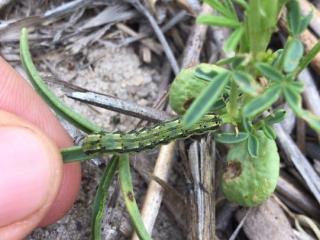Early caterpillar activity is a concern for future emerging crops
- Mingenew
- Ballidu
- Moora
- Elabbin
- Calingiri
- Narrogin
Recently there have been reports of unusually large amounts of caterpillar activity in volunteer crop re-growth, clovers and weeds across the northern and central wheatbelt.
Native budworm caterpillars have been found feeding on clover, volunteer lupins or roadside weeds in Mingenew, Ballidu, Narrogin and Calingiri. For more information refer to DPIRD’s Management and economic thresholds for native budworm page.
Ashleigh Donnison (DPIRD) recently found hawk moth caterpillars on weeds near Elabbin. A grower has also found hawk moth caterpillars at Ballidu.
There have also been reports of webworm moths and pasture day moth caterpillars across the central agricultural region.
While hawk moth caterpillars are very rarely seen damaging crops, native budworm, webworm and pasture day moth are known pests which could pose a risk to germinating crops.
Considerable summer rainfall from cyclonic activity has resulted in unusual moth flights from the north eastern pastoral areas to the northern and central agricultural regions. Caterpillars that have hatched have had green volunteer plant material (green bridge) to feed on.
Growers need to be mindful that caterpillars and other pests such as aphids may transfer from the green bridge into vulnerable emerging crops if the green bridge isn’t destroyed for at least two weeks before crop emergence. Caterpillars and aphids need a green host to feed on or they will starve and die. This includes eggs laid by moths which must hatch and do not go dormant on green or dead plant material in the lead up to crop germination.
Caterpillars can be tricky to correctly diagnose sometimes due to their similarities in appearance. Fortunately growers and consultants can use the free PestFax Reporter app to request a diagnosis. Users just need to take clear close up photos of the caterpillar and plant damage and attach with any other helpful background information when submitting a report.
For more information contact Dustin Severtson, Research Scientist, Northam on +61 (0)427 196 656 or Alan Lord, Technical Officer, South Perth on +61 (0)409 689 468 or Svetlana Micic, Research Scientist, Albany on +61 (0)427 772 051.
Article authors: Cindy Webster (DPIRD Narrogin) and Dusty Severtson (DPIRD Northam).


